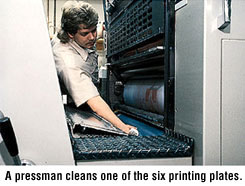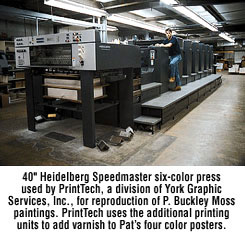LIMITED EDITION OFFSET REPRODUCTIONS
Offset reproduction refers to a photomechanical process of reproducing an original image by first "breaking down" or "separating" the artist's blend of colors into four constituent colors and then recombining them on a printing press to approximate the original work of art. This process, which takes approximately three weeks from start to finish, results in prints that are exactly the same throughout the press run. By using the highest quality acid-free rag paper and a faithful interpretation of the color and tone of Pat's original work, her print editions can honestly portray her message to Moss collectors even though she is not directly involved in the printing process. Because Pat limits the edition size of her prints, usually to 1,000 and 25 artist's proofs, they are known as limited edition offset reproductions and are highly collectible. The following process describes how Pat's original art becomes a print edition.
After Pat has completed an original watercolor painting in her studio, she allows her creation to be reproduced so many people will be able to enjoy her art since the demand for her art greatly exceeds her supply of originals. This reproduction process begins at The Moss Portfolio, where the image size, paper size, cost and edition size of the print are determined.

Once the preliminary production work is completed, the original watercolor is shipped to the printer where the print edition will be made. The first step in the printing process involves photographing the original with a special camera that separates the art colors into four printing colors. Using a color filter in front of the lens to absorb unwanted colors and transmit the wanted color, one continuous-tone negative is produced for each of the four colors used in printing. These colors are yellow, magenta (red), cyan (blue) and black. If the reproduction will be a different size from the original painting, cropping or reducing is done at this time.

Tonal values in each color negative are carefully compared to the original. Once this examination is complete, the image is projected through a camera lens and through a grid pattern to produce a screened positive of the image with a dot pattern. Fine dots in the pattern will print as light areas, while large dots make dark areas. As the dots blend together entirely, solid color areas appear. A halftone negative is made of each of the four colors, and again they are compared meticulously to the original.

The four color negatives are printed together to create color proofs that estimate how the finished print will look. These rough proofs are examined and fine adjustments are made to refine the image. Final proofs are approved by Pat or her representative. After any corrections are made, the film is "stripped" to another piece of clear film which is placed against a thin, light-sensitive aluminum plate. A powerful light source transfers the dot pattern for that color to the plate and developing solution makes the pattern visible. Once a separate plate has been made for each of the four colors it is time to go to press.

Offset lithography is based on the principle that oil and water do not mix. Each plate is mounted on a cylinder of the printing press. This cylinder is then exposed to a water roller. The water from this roller will not adhere to the grease-based printing image and will repel the ink from the non-image area. Next, from an ink roller, particles of ink adhere to each printing dot on the image plate. The inked area is then transferred to the offset blanket. This rubber blanket is used to transfer the ink onto the acid-free paper because it transfers the image more smoothly than the metal plate. Because the ink image does not go directly from the plate to the paper, it is considered offset printing.
All of Pat's offset reproductions are printed on the highest quality acid-free paper. The color-fast, fade resistant inks used are specially formulated to meet the standards of the Fine Art Trade Guild of Great Britain and cost about five times more than conventional inks. By using the highest quality materials and recommending conservation framing for archival permanence, Pat ensures that future generations can also enjoy her artwork. Even though the printing process does not occur in Pat's presence, she works closely with The Moss Portfolio staff and York Graphic Services, Inc., to insure that the reproduction genuinely represents her original artwork. Final approval of all print editions comes from Pat. The signature that appears on the prints warrants that each print is reproduced from a P. Buckley Moss original and meets her expectation of quality.